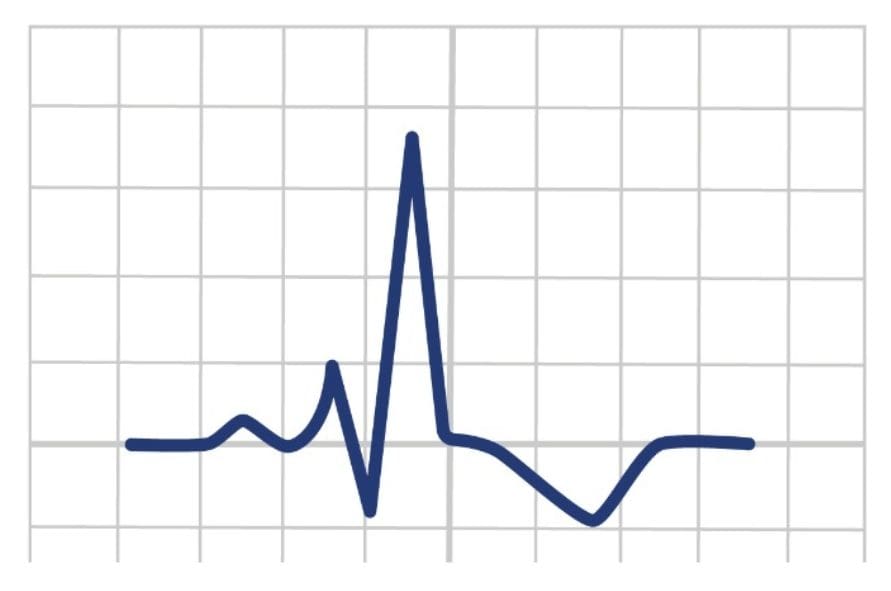Cardiac Axis
Cardiac Axis Introduction
Cardiac axis describes the overall direction of electrical impulses as they travel through the heart during the cardiac cycle. It shows the net effect of all the generated electrical potentials in the heart.
The cardiac axis is typically represented in degrees and can fall within a normal range or deviate from it, which can indicate various cardiac conditions.
When seeing a positive deflection on an ECG this represents that the electrical activity is traveling towards that particular ECG lead.
When seeing a negative deflection on an ECG this represents that the electrical activity is traveling away from that particular ECG lead.

Leads II and aVR views the heart electrical activity from opposite directions. The normal path of electrical through the heart is from the right atrium towards the left ventricles. Hence, in normal axis, Lead aVR would show a downward deflection (traveling away) where Lead II would show a positive deflection (traveling towards).
However, in different disease states, the cardiac axis can be alternated to the left or right.
Normal Cardiac Axis
As mentioned above, the cardiac axis is represented in degrees. In healthy patients, normal axis ranges from -30 degrees to +90 degrees.

As the electrical activity travels away from lead aVR towards leads I, II and III this would cause variation in deflections shown in these leads. The most positive deflection would be seen in Lead II as this is most aligned with the electrical pathway.
See the On Road Axis Calculation section below on how to quickly determine axis.
Left Cardiac Axis Deviation
Left axis deviation occurs when the direction of electrical activity is pushed towards the left – between -30 and -90. This results in Leads II and III showing negative deflection as the electrical impulse is now travelling away from the leads. Lead I still has a positive deflection.

Left axis deviation can suggest a left ventricular conduction abnormality such as a bundle branch, anterior fascicle or inferior MI.
Right Cardiac Axis Deviation
Right axis deviation would signify that the electrical impulses are shifted to the right – between +90 and +180.
This now would cause Lead II and Lead III to show positive deflection with Lead I showing negative deflection due to the electrical activity now going away from the lead.

Right ventricular hypertrophy may be indicated if right axis deviation is seen which can lead to pulmonary disease. Other causes of right axis deviation may include acute pulmonary embolism and lateral MI.
On The Road Cardiac Axis Calculation
When in a prehospital environment, it can difficult to work out axis deviation in degrees. Hence, a quick and easy way to work out axis deviation is by looking at leads I, II and III or aVF.

Conclusion
ECGs are a fundamental procedure in healthcare, providing invaluable insights into the heart’s electrical activity. Proper electrode placement, calibration, and standardisation are essential for accurate and reliable recordings. ECGs are critical for diagnosing a wide range of cardiac conditions and play a central role in patient care.
Key Points
- Normal Axis: The normal electrical axis of the heart falls between -30 degrees and +90 degrees.
- Left Axis Deviation (LAD): When the axis deviates leftward beyond -30 degrees, it may indicate conditions like left ventricular hypertrophy (LVH).
- Right Axis Deviation (RAD): A deviation beyond +90 degrees indicates rightward deviation. Causes include right ventricular hypertrophy (RVH).
Bibliography
Joint Royal Colleges Ambulance Liaison Committee and Association of Ambulance Chief Executives (2022). JRCALC Clinical Guidelines 2022. Class Professional Publishing
Kashou, A. H., Hajira Basit, & Lovely Chhabra. (2019, June 29). Electrical Axis (Normal, Right Axis Deviation, and Left Axis Deviation). Nih.gov; StatPearls Publishing. https://www.ncbi.nlm.nih.gov/books/NBK470532/
Introduction
Cardiac axis describes the overall direction of electrical impulses as they travel through the heart during the cardiac cycle. It shows the net effect of all the generated electrical potentials in the heart.
The cardiac axis is typically represented in degrees and can fall within a normal range or deviate from it, which can indicate various cardiac conditions.
When seeing a positive deflection on an ECG this represents that the electrical activity is traveling towards that particular ECG lead.
When seeing a negative deflection on an ECG this represents that the electrical activity is traveling away from that particular ECG lead.

Leads II and aVR views the heart electrical activity from opposite directions. The normal path of electrical through the heart is from the right atrium towards the left ventricles. Hence, in normal axis, Lead aVR would show a downward deflection (traveling away) where Lead II would show a positive deflection (traveling towards).
However, in different disease states, the cardiac axis can be alternated to the left or right.
Normal Axis
As mentioned above, the cardiac axis is represented in degrees. In healthy patients, normal axis ranges from -30 degrees to +90 degrees.

As the electrical activity travels away from lead aVR towards leads I, II and III this would cause variation in deflections shown in these leads. The most positive deflection would be seen in Lead II as this is most aligned with the electrical pathway.
See the On Road Axis Calculation section below on how to quickly determine axis.
Right Axis Deviation
Right axis deviation would signify that the electrical impulses are shifted to the right – between +90 and +180.
This now would cause Lead II and Lead III to show positive deflection with Lead I showing negative deflection due to the electrical activity now going away from the lead.

Right ventricular hypertrophy may be indicated if right axis deviation is seen which can lead to pulmonary disease. Other causes of right axis deviation may include acute pulmonary embolism and lateral MI.
Left Axis Deviation
Left axis deviation occurs when the direction of electrical activity is pushed towards the left – between -30 and -90. This results in Leads II and III showing negative deflection as the electrical impulse is now travelling away from the leads. Lead I still has a positive deflection.

Left axis deviation can suggest a left ventricular conduction abnormality such as a bundle branch, anterior fascicle or inferior MI.
On The Road Axis Calculation
When in a prehospital environment, it can difficult to work out axis deviation in degrees. Hence, a quick and easy way to work out axis deviation is by looking at leads I, II and III or aVF.

Conclusion
ECGs are a fundamental procedure in healthcare, providing invaluable insights into the heart’s electrical activity. Proper electrode placement, calibration, and standardisation are essential for accurate and reliable recordings. ECGs are critical for diagnosing a wide range of cardiac conditions and play a central role in patient care.
Key Points
- Normal Axis: The normal electrical axis of the heart falls between -30 degrees and +90 degrees.
- Left Axis Deviation (LAD): When the axis deviates leftward beyond -30 degrees, it may indicate conditions like left ventricular hypertrophy (LVH).
- Right Axis Deviation (RAD): A deviation beyond +90 degrees indicates rightward deviation. Causes include right ventricular hypertrophy (RVH).
Bibliography
Joint Royal Colleges Ambulance Liaison Committee and Association of Ambulance Chief Executives (2022). JRCALC Clinical Guidelines 2022. Class Professional Publishing
Kashou, A. H., Hajira Basit, & Lovely Chhabra. (2019, June 29). Electrical Axis (Normal, Right Axis Deviation, and Left Axis Deviation). Nih.gov; StatPearls Publishing. https://www.ncbi.nlm.nih.gov/books/NBK470532/

